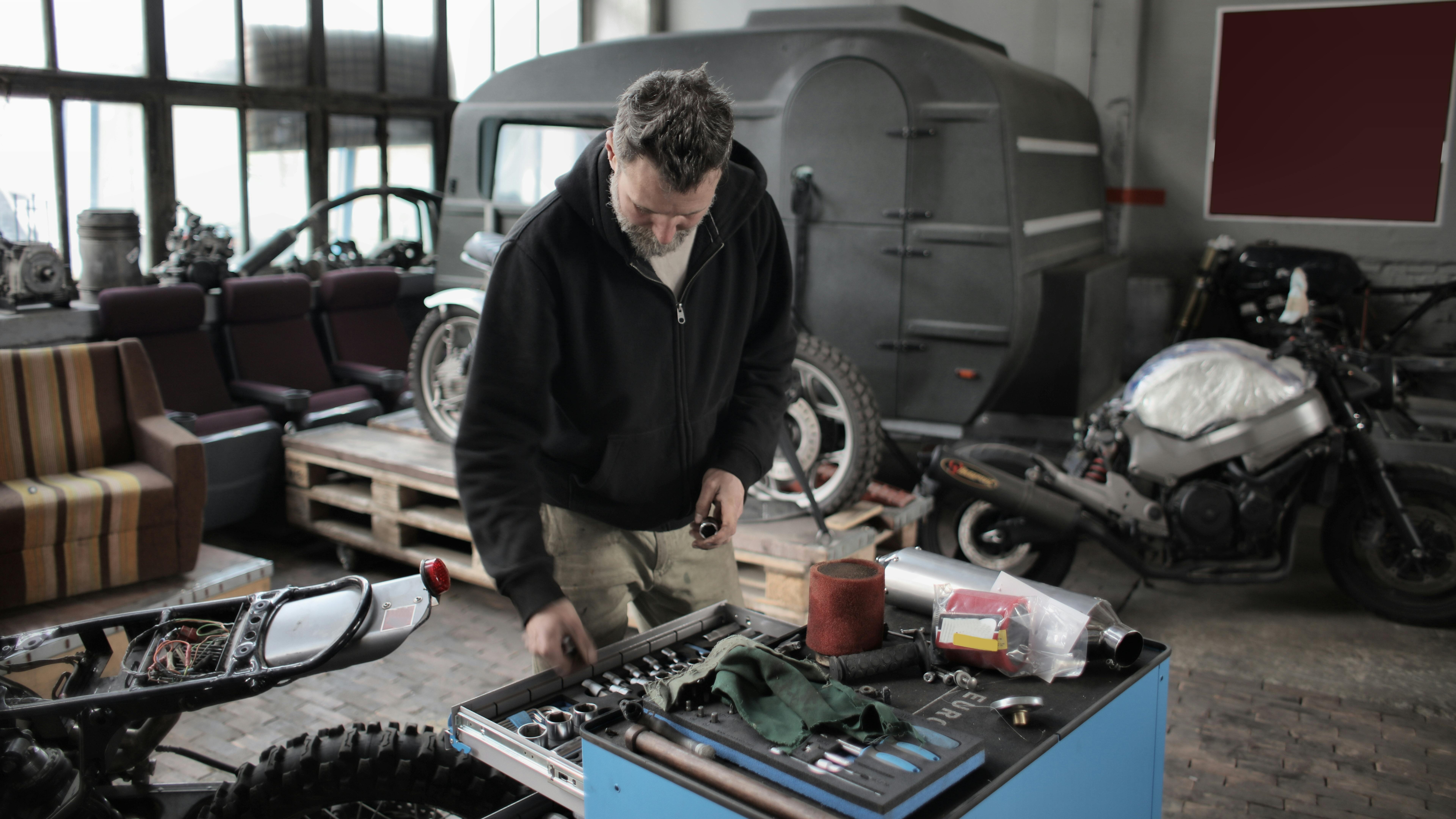Did you know nearly 80% of roadside motorcycle breakdowns can be fixed on the spot—if you have just a handful of basic motorcycle tools on hand? Whether you’re an experienced rider or gearing up for your first trip, your ability to keep your motorcycle running smoothly could come down to how well you’ve prepared your motorcycle tool kit. In this guide, we break down the 11 essential basic motorcycle tools every motorcycle rider should have on hand, practical tips for building the perfect tool set, and expert insights to ensure your rides are safe and hassle-free. Don’t let a minor breakdown cut your journey short—discover the must-have tools that empower every rider!

Why You Need Basic Motorcycle Tools: Surprising Stats Every Rider Should Know
Did you know that nearly 80% of roadside motorcycle breakdowns can be resolved on the spot with just a handful of basic motorcycle tools? Discover why thoughtful tool preparation is the unsung hero of motorcycle maintenance and rider safety.
Motorcycle riders face unique challenges on the road, from unexpected mechanical issues to simple adjustments like tightening a loose mirror or fixing a flat tire. The good news? According to recent surveys, most breakdowns can be fixed immediately if the rider has access to basic motorcycle tools. A thoughtfully assembled motorcycle tool kit not only ensures you’re prepared for emergencies but also empowers you to complete regular motorcycle maintenance—keeping your motorcycle running smoothly and boosting your confidence on every trip.
The right combination of hand tools and specialty items reduces the risk of being stranded, saves you money on repairs, and extends the life of your ride. Many riders overlook the value of basic motorcycle maintenance tools until an inconvenient breakdown reminds them. Investing a little time and effort upfront can mean the difference between a minor pit-stop and a major disruption to your journey.
What You'll Gain from This Guide to Basic Motorcycle Tools
A comprehensive checklist of basic motorcycle tools every motorcycle rider should have
Practical tips for building your first tool kit
Insights on how each motorcycle tool supports effective motorcycle maintenance
This guide is more than a list of tools—it's a roadmap to motorcycle self-sufficiency . We cover step-by-step strategies for assembling the ideal motorcycle tool kit , break down how each item supports hands-on motorcycle maintenance and repairs, and offer real-world advice so you can ride with confidence. Whether you’re new to motorcycle repair or fine-tuning your seasoned kit, our expert-backed guidance will help you make the smart choices that keep your motorcycle running smoothly, trip after trip.
Quick Reference Table: Must-Have Basic Motorcycle Tools for Every Motorcycle Rider
Tool Name |
Function |
Essential Use Case |
|---|---|---|
Combination Wrench Set |
Adjusting nuts and bolts |
Chain tension, brake levers |
Torque Wrench |
Accurate bolt tightening |
Engine and chassis work |
Tire Pressure Gauge |
Checking tire health |
Pre-ride tire check |
Hex Keys / Allen Wrenches |
Fastener tightening |
Controls, bodywork |
Socket Wrench Set |
Versatile fastening |
General repairs |
Screwdrivers |
Universal fastening |
Electrical, bodywork |
Pliers |
Versatile gripping |
Hoses, quick fixes |
Oil Filter Wrench |
Maintenance |
Oil change |
Impact Driver |
Stubborn fasteners |
Body and engine |
Chain Lube & Brush |
Chain maintenance |
Ride readiness |
Portable Air Pump |
Emergency inflation |
Tire punctures |
1. Combination Wrench Set: The Foundation of Basic Motorcycle Tools
Understanding the Role of the Combination Wrench in Motorcycle Maintenance
Why combination wrenches matter for motorcycle repair
Sizing matters: Metric vs. SAE for your tool kit
Proper wrench use and safety tips
Combination wrenches are the unsung heroes in every motorcycle tool kit. Their dual-end design—open on one side for speed, closed on the other for grip—lets riders tackle everything from chain tension adjustments to brake lever tightening. Most motorcycles use metric fasteners, so a quality metric wrench set is a must, but having SAE options can be a lifesaver for older or custom bikes. Always match wrench size to bolt head for the best fit. Proper technique, such as pulling rather than pushing, not only applies maximum torque but also reduces your risk of injury. Regularly inspect your wrenches for wear—rounded edges can slip, causing damage or even injury. A solid set of combination wrenches keeps your motorcycle running smoothly by making regular and emergency repairs straightforward, precise, and safe.
When selecting your first wrench set, consider durability and material—chrome vanadium steel resists rust and stands up to repeated use. Most motorcycle riders prefer sets that come in a roll-up pouch or dedicated case for easy transport and organization. With properly sized and stored wrenches, roadside repairs become much less intimidating and significantly less hazardous.
2. Torque Wrench: Prevent Over-Tightening with This Crucial Motorcycle Tool
Choosing and Using a Torque Wrench for Basic Motorcycle Maintenance
Pre-set vs. adjustable torque wrenches
Key areas where correct torque is vital
How a torque wrench extends component life
A torque wrench is essential for any rider who wants to avoid the costly and dangerous mistakes of over- or under-tightening critical bolts. Unlike standard hand tools, torque wrenches are designed to apply a specific level of force, ensuring fasteners stay secure without risking damage to sensitive engine or chassis components. There are both pre-set and adjustable torque wrenches; pre-set styles are perfect for commonly repeated tasks, while adjustable versions offer versatility for the changing demands of motorcycle maintenance.
Correct torque application is crucial for areas like cylinder head bolts, axle nuts, and brake calipers—bolts that, if mishandled, can jeopardize your safety or the integrity of your ride. By using a properly calibrated tool, you extend the lifespan of your motorcycle’s parts and guarantee everything is held together with factory-level precision. Invest in a reputable brand and always store your wrench at its lowest setting to preserve accuracy. Understanding torque settings for your specific motorcycle model will maximize your maintenance confidence and keep you riding safely.
3. Tire Pressure Gauge: A Basic Tool to Maximize Safety and Performance
How a Tire Pressure Gauge Supports Motorcycle Rider Safety
Types of tire pressure gauges for motorcycle tool kits
When and how to check tire pressure
The link between tire pressure and ride quality
A reliable tire pressure gauge is one of the most important basic motorcycle tools in your kit. Maintaining proper tire pressure is not just about performance—it’s about safety, durability, and ride comfort. Options range from classic analog dials to advanced digital models, each offering distinct readability and accuracy benefits. Whichever you choose, make sure it’s suitable for your tire’s valve type and fits neatly in your travel tool roll.
Contrast between riding with correctly inflated tires and under- or over-inflated ones is dramatic: poor pressure compromises handling, increases the risk of blowouts, and accelerates tire wear. For daily riders and long-haul adventurers alike, checking tire pressure before every ride should become second nature. This quick routine, using your pressure gauge, will help you catch minor problems before they become major breakdowns—and keep your motorcycle running smoothly mile after mile.
4. Hex Keys: The Small but Mighty Motorcycle Maintenance Tool
Selecting the Right Hex Key and Allen Wrench Set for Motorcycle Tools
Common fastener sizes on most motorcycles
L-keys, folding sets, and T-handles
Pro tips for snug, damage-free tightening
Hex keys (or Allen wrenches) are indispensable for accessing bodywork panels, controls, and accessory mounts on your motorcycle. The most-used sizes are typically 4mm, 5mm, and 6mm for metric fasteners—though a complete key set covers all potential needs. Choose between classic L-shaped keys for portability, robust T-handles for greater leverage, or folding sets for travel convenience.
The right hex key set ensures you can perform precise adjustments without risk of rounding bolt heads. Always push the tool squarely into the fastener and apply steady pressure to avoid slip-outs or stripped screws. Quality keys made from hardened steel promise the reliability you need on the road. Take time to familiarize yourself with the fasteners on your bike and match your kit accordingly—a small, carefully chosen hex key set can address the vast majority of roadside repairs and routine tweaks.
5. Socket Wrench Set: Versatile Basic Tool for Every Motorcycle Tool Kit
Building a Comprehensive Socket Wrench Set for Home and Travel
Must-have socket sizes for basic motorcycle tools
Ratchet handles, extensions, and adapters
Fast, reliable fastening in tight spaces
A socket wrench set adds versatility and speed to your motorcycle repair toolkit. Unlike fixed-end wrenches, socket wrenches with ratcheting handles allow fast and efficient removal or installation of bolts and nuts—particularly in tight or awkward spaces around your motorcycle’s frame, wheels, and engine. The most common drive size for motorcycles is 3/8-inch, so prioritize both metric and SAE sockets in 8mm to 17mm range.
A full tool set should include a compact ratchet handle, extensions for hard-to-reach areas, and a set of adapters for socket compatibility. When packed in a sturdy, portable case or tool roll, your socket wrench set will always be ready for action, both in the garage and on the roadside. Always double-check your motorcycle’s fasteners and match your sockets accordingly; investing in a comprehensive yet portable set will dramatically expand your maintenance capabilities.
6. Screwdrivers: Simple Hand Tools That Solve Big Motorcycle Maintenance Problems
Why Various Screwdriver Types Should Be in Every Motorcycle Rider’s Tool Kit
Slotted, Phillips, and JIS screwdrivers—what’s the difference?
How to avoid stripping screws on your motorcycle
Storing screwdrivers to prolong tool life
It’s easy to underestimate the power of a good screwdriver set , but these basic hand tools are invaluable for every motorcycle rider . Japanese Industrial Standard (JIS) screwdrivers fit the majority of Japanese-made motorcycle screws and prevent the cam-out issues common with standard Phillips driver heads. Still, having a set with slotted (flat), Phillips, and JIS styles ensures you never strip a fastener.
When using screwdrivers, apply steady pressure and match the tip perfectly to the screw slot for maximum grip. Investing in cushioned, non-slip handles can reduce hand fatigue. Keep your drivers organized in a tool roll or dedicated case to protect them from damage and maintain tip integrity. Properly maintained screwdrivers will outlast most other items in your kit—and can mean the difference between a quick fix and a complicated repair.
7. Pliers Set: The All-Purpose Hand Tool for the Motorcycle Rider
Multipurpose Use Cases for Pliers in Motorcycle Repair
Needle-nose, locking, and slip-joint pliers
Common repairs pliers help solve
Safety tips for maximum grip and control
A quality pliers set gives you gripping strength and precision control for a variety of on-the-road emergencies. Needle-nose pliers excel at retrieving dropped washers or pulling stubborn cotter pins, while slip-joint and locking (vise-grip) pliers are crucial for holding, twisting, or cutting wires and hoses. With their adaptability, pliers are a staple hand tool for both planned maintenance and unexpected fixes.
Always check that the jaws and grip surfaces are intact, free from rust or soft spots, as even minor defects can compromise your safety during use. For maximum control, maintain a firm but gentle grip and avoid excessive force to prevent slipping or damage to small motorcycle parts. Consider pliers with insulated handles for dealing with electrical issues, and make sure to include at least two types in even the most minimalist motorcycle tool kit.
8. Oil Filter Wrench: Making Oil Changes Easy with Specialized Basic Tools
How to Choose the Right Oil Filter Tool for Motorcycle Maintenance
Band vs. cap-style oil filter wrenches
Step-by-step oil filter change
Preventing leaks with the proper tool
The oil filter wrench is a specialized tool designed to make oil changes fast, clean, and efficient. Band-style wrenches adjust for various filter sizes and grip tightly, while cap-style wrenches fit specific filters for a snug, non-slip removal. Choosing the right tool depends on your motorcycle’s make and your own maintenance habits—if you change oil frequently, invest in a dedicated wrench for your filter size.
Oil changes are a cornerstone of motorcycle maintenance, preventing excess engine wear and keeping your bike running smoothly. With the correct oil filter tool, you minimize the risk of leaks and spills while ensuring the new filter is properly torqued in place. Always lubricate the O-ring and never over-tighten during reinstallation—a properly executed oil change extends your engine’s life and reduces the risk of roadside breakdowns.
9. Impact Driver: Tough Fasteners Demand This Specialized Motorcycle Tool
When and How to Use an Impact Driver in Your Tool Set
Breaking loose corroded or stuck screws
Manual vs. powered impact drivers
Safety precautions when using impact tools
A manual or powered impact driver is invaluable when you encounter rusted or overtightened fasteners that regular screwdrivers can’t budge. These maintenance tools deliver short, controlled bursts of force, transmitting energy directly into the fastener to free stuck screws without stripping. For most riders, a manual model is compact and portable; powered options offer more torque but are best suited to home garages rather than roadside repairs.
When using an impact driver, always wear gloves and eye protection and ensure you have the right bit fitted firmly. Apply focused force and never use the tool on sensitive or small fasteners without verifying they can take the impact. This tool should be the last resort for stubborn screws and a must-have for anyone crossing long or remote distances on their motorcycle.
10. Chain Lube and Cleaning Brush: Everyday Motorcycle Maintenance Made Simple
The Correct Way to Use Chain Lube and Extend Chain Life
Benefits of regular cleaning and lubrication
Best chain lube types for your climate
Cleaning techniques for a safe, smooth ride
Keeping your motorcycle chain clean and well-lubricated is critical to safe and efficient riding. Chain lube and a good cleaning brush are basic maintenance tools you can’t overlook. Regularly applying the correct chain lube type—wax, spray, or oil—prevents premature wear, protects against rust, and improves the motorcycle's overall running smoothness.
Choose a lube that matches your climate (dry vs. wet) for the best protection and apply after cleaning with a bristled brush or dedicated chain cleaning tool. Make this maintenance task part of your routine, ideally every few hundred miles or after rainy/dirty rides. Clean and lubricate the chain with the bike in neutral, rotating the wheel gently and applying lube evenly for long, reliable chain life.
11. Portable Air Pump: Stay Prepared with This Basic Motorcycle Tool
Why a Portable Air Compressor Matters for the Motorcycle Rider
Compact versus manual pumps
When and how to inflate tires on the road
Integrating the pump with your full motorcycle tool kit
A portable air pump or mini air compressor lets you handle tire pressure issues wherever your journey takes you. Choose between compact electric models that plug into the bike’s battery or traditional manual pumps which require no external power. The convenience of an air tool that fits your saddlebag or tail pack cannot be overstated—inflatting a punctured tire, topping up after a cold snap, or helping a fellow rider is effortless with the right pump.
To use: attach the pump to the valve stem, set your pressure gauge, and inflate to the recommended psi. Always pack your pump with adapters for different valve types and ensure it's compatible with the rest of your tool kit. The added security a portable air tool provides means peace of mind and ensures your ride continues with minimal delay after roadside setbacks.
A walkthrough demonstration showing how to use each of the must-have motorcycle tools discussed. Real-world scenarios for effective and safe application.
Expert Insights: Quotes from Pro Riders on Basic Motorcycle Tools
"A well-stocked tool kit isn’t a luxury for a motorcycle rider—it’s essential insurance for every trip, long or short." – James R., Certified Motorcycle Mechanic
"Relying on your tools is as important as relying on your skills. Never head out without the basics." – Sarah K., Adventure Touring Rider
People Also Ask: Essential Questions About Basic Motorcycle Tools
What tools are needed for a motorcycle?
A comprehensive motorcycle tool kit typically includes combination wrenches, torque wrench, screwdrivers, tire pressure gauge, pliers, socket wrench set, hex keys, oil filter wrench, impact driver, chain lube, and a portable air pump for mishaps and maintenance.
What to have in a motorcycle tool kit?
A basic motorcycle tool kit should include key hand tools: combination wrenches, hex keys, screwdrivers, pliers, tire pressure gauge, chain lube, impact driver, oil filter wrench, and a portable air pump so you are prepared for quick fixes and preventive maintenance.
Which all basic tools should a rider keep with him/her for a ride?
A motorcycle rider should always carry a minimalist version of the main tool set: tire pressure gauge, combination wrench, hex keys, pliers, screwdriver, portable air pump, and chain lube to remedy common roadside issues.
What is the most common wrench for motorcycles?
The most essential wrench for motorcycles is the combination wrench—typically metric sizes. These are used for most adjustments and maintenance, making them irreplaceable in every motorcycle tool kit.
Choosing Your First Basic Motorcycle Tool Set: Practical Buying Tips
Quality vs. quantity in hand tools
Setting a budget for long-term value
Recommended brands and retailers for motorcycle tools
When building your first motorcycle tool set, balance quality against cost. It’s better to purchase fewer, higher-quality hand tools than cheaper alternatives that risk breaking under pressure. Start with the most essential items, then expand as your needs grow. Check for lifetime warranties and rust resistance, and prioritize brands known for durability. Shopping at motorcycle shops or specialty tool retailers often guarantees both quality advice and legitimate products.
Set a realistic budget, keeping in mind that quality tools provide years of reliable use. Read rider reviews and seek recommendations to avoid unnecessary purchases. Remember—your motorcycle tool kit is an investment in both safety and convenience.
Pro Tips for Packing Your Motorcycle Tool Kit Efficiently
How to organize tools for quick access
Storage options: rolls, pouches, and boxes
Weatherproofing and anti-corrosion strategies
Organization is the difference between a valuable tool kit and a frustrating mess. Store your tools in a weatherproof tool roll or sturdy pouch designed for motorcycles—efficiently sorted tools mean repairs are faster and less stressful. Add silica gel packs or anti-corrosion treatments to protect from road moisture and rust.
Place commonly-used items in easily accessible sections, and check your kit before every big ride. Customizing the order and grouping of your tools around your most frequent maintenance tasks can turn a chaotic roadside situation into a simple five-minute fix.
Detailed video demonstration on building a motorcycle maintenance toolkit, using each essential tool, and preparing for emergencies.
Common Mistakes to Avoid with Basic Motorcycle Tools and Maintenance
Over-tightening or under-tightening fasteners
Using the wrong hand tool for the job
Neglecting to check tire pressure before every ride
Even seasoned riders can make basic errors, often with serious consequences:
Over-tightening fasteners can strip threads or crack components.
Using mismatched hand tools (such as the wrong size hex key or screwdriver) causes damage and steep repair bills down the line.
Neglecting tire pressure checks jeopardizes both safety and motorcycle handling.
FAQs on Basic Motorcycle Tools for Riders
What are the safest ways to use a torque wrench?
Always start by reading the tool’s manual, set the correct torque specifications from your motorcycle's manual, and apply slow, steady pressure. Store your torque wrench at its lowest setting to maintain accuracy.Should I carry spare parts along with my basic tools?
Yes, carry common spares like fuses, bulbs, and extra chain links for your model, especially on longer trips where parts shops aren’t nearby.Are multi-tools a good substitute for individual motorcycle tools?
Multi-tools are useful for minor repairs, but dedicated hand tools usually offer better grip, torque, and safety for tougher maintenance tasks.Why do motorcycles need special hand tools versus auto tools?
Motorcycles often use smaller, tighter fasteners and different standards (metric vs. SAE) than cars. Tools sized and designed for motorcycles ensure better fit and prevent accidental damage.
Key Takeaways for Every Motorcycle Rider: Building the Right Basic Motorcycle Tool Kit
Start with the top-11 tools, then personalize
Regularly inspect and upgrade your tool kit
Practice using each basic motorcycle tool before you need it roadside
Building your motorcycle tool kit is the first step; keeping it updated and practicing your skills ensures you’re ready for anything the road throws at you.
Ready to Build Your Tool Kit? Call Us for Advice on Basic Motorcycle Tools
Still have questions? Call Us Today: 847-458-4858 and let our experienced staff help you build the perfect basic motorcycle tools kit for your next ride.
To further enhance your understanding of essential motorcycle tools, consider exploring the following resources:
“Essential Motorcycle Tools Every Technician Should Know” : This article from Universal Technical Institute provides a comprehensive overview of the fundamental tools necessary for motorcycle maintenance, including wrenches, sockets, and screwdrivers. ( uti.edu )
“The Motorcycle Maintenance Tools Every Rider Should Own” : Law Tigers outlines crucial tools such as tire compressors, battery chargers, and multimeters, emphasizing their importance in routine motorcycle upkeep. ( lawtigers.com )
These resources offer valuable insights into assembling a well-rounded motorcycle tool kit, ensuring you’re prepared for both routine maintenance and unexpected repairs.
 Add Row
Add Row  Add
Add 



Write A Comment